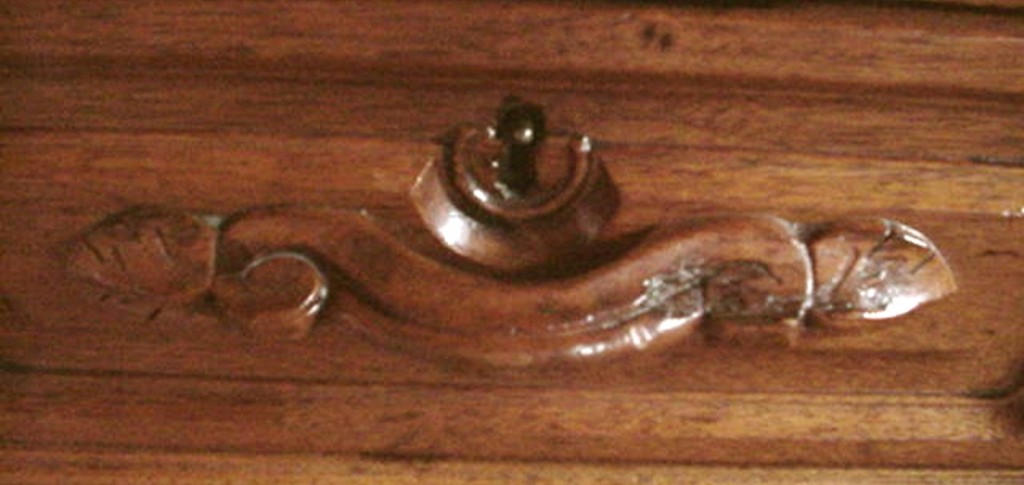
The circular wooden escutcheons on these keyholes are from the Renaissance Revival period of the 1870s/1880. Then top half of the upper escutcheon is broken off.
When you examine almost any older or antique piece of furniture which has doors, drawers, a drop front, a tambour or a lid you almost certainly, sooner or later, will find a lock. To operate the lock, naturally, there is a keyhole. And, except in some of the more primitive cases, the keyhole is almost always adorned in some manner; i.e. it is usually not just a raw hole in the wood. You may often find just such a raw hole in a piece that has been well worn, but closer examination will reveal that something is missing.
What is missing is the keyhole companion, that piece of decorative artwork that imparts that overall “finished” look to the piece of furniture. This little decoration generally comes in two major categories, key surrounds and escutcheons.
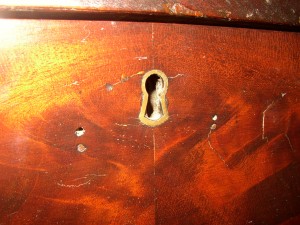 This is a typical mid 19th century American flush mount key surround, circa 1840-1850. | 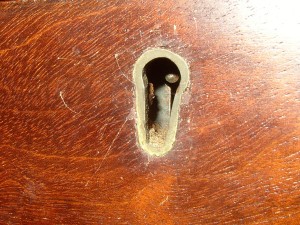 This more oval shaped flush mounted surround is of English make, late 19th century. |  This is a surface-mounted surround (with key) from the early 20th century. |
KEY SURROUNDS: These are the decorative items lining the keyhole and duplicate the shape of the keyhole in some other material. The most common surround is made of brass—either stamped or cast—but other materials are used as well. For example, in some Federal pieces the key surround is made of ivory. You may not even notice these items when you first survey a piece, and they generally aren’t of concern until either a key surround is missing or it must be removed for refinishing or repair.
Surrounds are generally found in two types: flush mount and surface mount. Flush surrounds are found in almost all 18th-century and mid-19th-century pieces, as well as many well-made modern reproductions. Flush mount surrounds are usually cast brass and inserted into the keyhole with a small amount of force and are held in place by the pressure of the wood. If the surround is tight and flush there is no need to remove it for refinishing. Just take care not to scratch it when sanding and be sure to get any stripper residue out of it before finishing. The lock should have been removed previously. If the surround is slightly raised above the surface it should be tapped back into place. Rather than striking the surround directly use a small piece of wood or the flat end of a dowel between the surround and the hammer. A smart blow should reset the surround. Be sure not to mar the surface. If it is loose, remove it and reinsert it using a small amount of five-minute epoxy. Be sure to put the epoxy in the keyhole, not on the edges of the surround or you will get glue on the surface of your work. If you are refinishing, be sure to keep the surround free of any additional color you may be using so the brass will be clear and bright when you apply a clear finish.
The other type of surround is surface mounted. These are found on late 19th- and early 20th-century pieces, especially turn-of-the-century oak and second-generation empire. These surrounds also duplicate the shape of the keyhole and may be stamped or cast, but the main part of the surround sits on the surface of the drawer or door and has a neck inserted into the keyhole to hold it in place. These surface-mounted surrounds should always be removed for refinishing, which can sometimes be a problem since you can’t always see how they are fastened, if at all. Some surface mounts are held in by the pressure of the neck, which has been bent slightly to grip the wood. Others, especially older cast surrounds, may have an incredibly tiny nail inserted through it on the inside to hold it in the keyhole. If you do not detect this nail and pry the surround off without removing it, you may tear the wood. Inspect the surround carefully before removal. Installation is similar to that of the flush mount. Slightly distort the neck for grip and use epoxy in the keyhole.
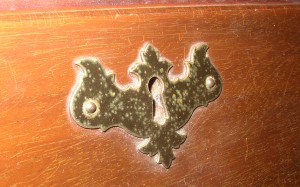 This Chippendale batwing escutcheon is from the 1940s. | 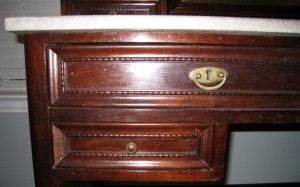 This desk drawer combines a drawer pull with an escutcheon. | 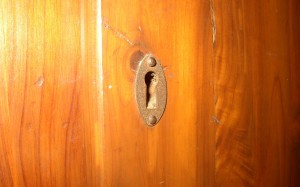 This is a simple surface mounted escutcheon, circa 1920s. |
ESCUTCHEONS: These are the other major category of keyhole companions. Escutcheons are decorative plates which are nailed or screwed over the keyhole on the surface to protect the surrounding wood. Escutcheons are made of a variety of materials, including brass, copper, tin wood and plaster. Escutcheons, like surface mount surrounds, should always be removed for major work on the piece. Most escutcheons are held onto the surface by small nails cleverly called “escutcheon pins.” These can be removed by inserting a thin flat blade such as a table knife behind the escutcheon and gently lifting near the pin. This should raise the head of the pin enough to grasp and remove it using dykes or pliers. Just be careful not to damage the escutcheon or the surrounding wood with the tools. Save the pins if possible for reuse or install new ones if necessary. They are readily available at most hardware stores.
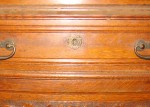
This turn of the 20th century bookcase drawer has a very unusual Star of David escutcheon.
If an escutcheon is missing, replacements are available from a variety of woodworking, furniture and finishing sources. The main trick in picking a replacement escutcheon is consistency of style. A Victorian walnut cabinet, which should have round walnut escutcheon, looks terrible if someone installs a Chippendale batwing plate. Likewise, an early 20th-century, second-generation Empire piece looks foolish with Queen Anne or Eastlake hardware. Pay attention to style and period in the selection of escutcheon plates.
One last note about escutcheons: If the plate is fairly small and the underlying lock mechanism is large, you may have trouble with installation since the pins won’t go into the sub surface lock. In this case you have to cut the pins with a pair of dykes to make them fit and fatter pins work better for this application.








![Validate my Atom 1.0 feed [Valid Atom 1.0]](valid-atom.png)











0 comments:
Post a Comment